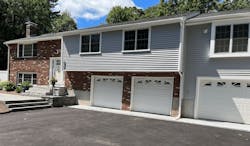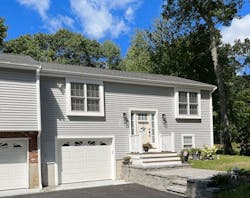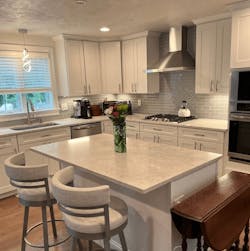It had been a few years since I visited my dear Aunt Nancy at her home in the leafy green Boston suburb of Hanover, Mass. Her split-level ranch, full of memories of family holidays and summer barbecues, looked familiar … except for a recently sprouted 794-square-foot in-law wing on its right side.
Aunt Nancy now lives in the new wing, while my cousin Toni, her husband, Tom, and their two sons live in the original house.
Toni grew up in that house and has a lot of emotional attachment to the property. After her father (my uncle Rob) passed away several years ago, the family debated what to do with the home and where my aunt should live. The family investigated the option of buying an existing home with an in-law suite, but they were few and far between and too small for their needs, Toni told me.
The solution was to add on to Aunt Nancy’s house to create a place where she could live comfortably and independently and relieve her of the burden of maintaining her longtime home and make it easier for Toni to my aunt out as she aged.
Aging in Place—Part of a Larger Trend
This project delivered what the family desired: an aging-in-place apartment; a housing type that is becoming increasingly common in both the home remodeling and new-home segments of the market. The number of homes with attached or detached accessory dwelling units (ADUs) grew from fewer than 9,000 (or 1.1%) of all homes sold in 2000 to nearly 70,000 (or 4.2%) in 2019, according to according to Freddie Mac.
Most likely, the popularity of ADUs has only increased since then, as the COVID-19 pandemic drove more people to either add them to their existing homes or request them in a new-home build to better enable remote work and schooling, gain additional income from renters or vacationers, or to accommodate multigenerational households like my aunt and her family. Several cities are also rezoning single-family neighborhoods to allow ADUs as an affordable housing option.
An ADU Construction Process Not Without Hiccups
Aunt Nancy’s project incurred plenty of challenges, though, and provides valuable lessons for those pursuing similar additions to suburban homes and for builders hired to construct them or include them in their new-home products.
It took a few years for the family, including Aunt Nancy, to green-light the project. They sought advice from a contractor that had remodeled Toni’s house and had renovated a hairdressing salon the family used to own.
“We dragged him over to my mom’s house about once a year for a few years to assess our plans,” Toni says. The family had implicit trust in the contractor due to their previous relationship, a situation that turned out to have a downside as Toni came to regret a loose approach to planning the addition, especially regarding the permitting process.
Hanover, a well-to-do community with mostly single-family homes and little dense residential development, has a rigorous permitting process for home additions, as well as rules about in-law suites, limiting them to 800 square feet and barring them from being rental units to anyone outside of the owners’ family.
RELATED
- ADU Design Ideas for Greater Housing Choice
- Builders Turn to ADUs to Fast Track Affordable Housing
- Much Ado About ADUs
As such, obtaining a permit requires the homeowner to inform neighbors of the project and allow for public input at a zoning board meeting. This caught Toni and Tom off guard because the contractor had assumed they knew this procedure and didn’t bring it to their attention. They only found out about this stipulation after they applied for the construction permit.
Undeterred, Toni provided the town hall with a letter outlining the project, and town administrators sent the letter to about 140 residents—most of whom live in a condo complex barely within the zone considered to be affected by the project. The result: Not a single comment was sent to the town hall, and nobody appeared at the zoning board’s Zoom meeting to air their views on the proposal, good or bad.
The early stages of the project went just as smoothly. The architect’s plans passed muster with everyone, though Aunt Nancy wasn’t sure about the design until she saw an HGTV-style rendering of the kitchen … and then gave her blessing to the whole plan. “If you just show me a piece of paper, I don’t know what to think about it,” she says. And they say technology is only for the young!
The first phase of construction was a full replacement and expansion of the septic system, followed by foundation and framing stages finished right on schedule. “We were thinking this is going to go great,” Toni remembers.
The COVID Effect Takes Hold With Supply Chain Disruptions
Then the COVID supply chain crunch hit, including a 12-week delay to get six windows and three doors. Toni and Tom were surprised to find out the local code stipulated that the home could not be wired until the windows and doors were in place. While some plumbing work could go ahead, the delay on wiring pushed the project back three months—another surprise from the contractor.
Unfortunately, the project bottlenecks didn’t end after windows and doors were installed. The next snag concerned how to heat the new wing. One option was to run a new gas line from the street to the addition, but this would have been a major hit to the budget and there was no reliable timeline for the gas utility to install it.
A plumber recommended another option: an on-site propane system, a solution that promised to be cheaper and easier, he said, than installing a new gas line or running gas from the existing home system into the new wing. The contractor agreed.
But there was a regulatory hitch. After many frustrating rounds of calls to the local utility and a local propane supplier, Toni and Tom learned that regulations prohibited having both natural gas and propane to fuel the same house.
RELATED
- 5 Supply-Chain Takeaways From the Pandemic
- Housing's New Now
- Supply Chain Solutions: 3 Tactics for Home Builders
The propane dealer requested a letter of approval from the utility, to which its representatives reportedly said, “We don’t do that.” The contractor also was unable to help the situation, and to be fair, combining gas and propane to fuel a single home was so unusual that even the utility regulating the practice wasn’t aware of the rules and details behind them.
Finally, after weeks of aggravation, in Fall 2021, Toni asked a worker for the local utility she knew through her sons’ school activities, and he shed more light on the regulation that prohibited propane and recommended they run the gas supply line from the main house to the new wing. This strategy, though, meant that only one gas meter would serve both households, so Toni and Tom would have to share the monthly bill with Aunt Nancy.
Closing on Success: The ADU Project Wraps Up
The rest of the project unfolded well. By New Year’s Day 2022, Aunt Nancy had settled into her new home. Despite the frustrations, the project was ultimately a success. Both Toni and Nancy love the arrangement. “I didn’t expect to have gotten used to it so fast,” Nancy says.
The new wing is completely separated from the original house, save for an archway connecting the garages. “I go over for coffee in the morning and usually go over for a while at night,” Toni says. “I don’t feel like we live together.”
The original estimate of $240,000 had factored in several thousand dollars extra for contingencies—all of which was eaten up by the material cost spike during the pandemic and the gas supply issue. Still, having that “padding” in the budget was fortunate planning.
Reflecting on interactions with the contractor, Toni had a few observations. “He seemed to be waiting for subcontractors a lot,” she says. But her biggest frustration was feeling out of the loop on scheduling and how codes and regulations affected the project. The contractor usually returned calls within a reasonable time, she says, but his lack of clarity communicating was sometimes a problem.
“Mom had a few testy chats with him,” Toni says. “I would hire him again for something like a kitchen renovation or to take down a wall, but I probably wouldn’t recommend him for a project like this.”
How Can Builders Better Serve Clients on ADU Additions?
- Anticipate permitting requirements and procedures, and help clients understand and prepare for the permitting process.
- Explain zoning issues. Regulations for ADUs vary by community, and many require a special permit, which can be a months-long process.
- Communicate timelines clearly. If you don’t know when a critical material will be available, be honest and upfront about it and explain why this may cause a schedule delay and cost increases.
- Know the owner’s situation and deadlines and be transparent about the impact of schedule delays.
- Know the rules for utilities pertaining to installing, extending, or combining them.
Based in the Boston area, Peter Fabris is a freelance writer who has covered the built environment for more than 15 years.



